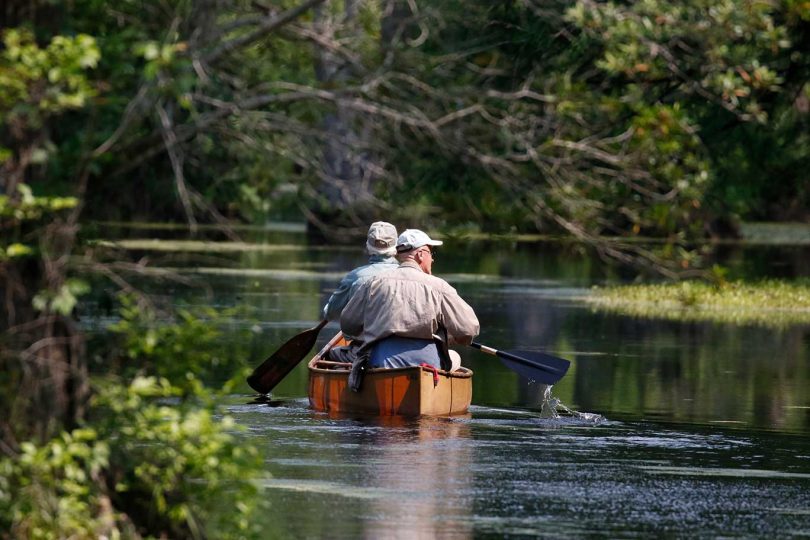Luis Suau
Above: Canoe leaving Merchants Millpond SP boat ramp en route to campsite through swamp. That’s a 4.5m paddle. PHOTO BY LUIS SUAU
Canoe camping is one of the most thrilling camping activities anyone can experience. For many it’s the search for independence and seclusion, for others, the activity is close to a religion.
The term canoe camping is often misunderstood if you haven’t experienced it. There is a big difference between camping with canoes and canoe camping, with the latter being one of the most traditional forms of outdoor independence. In simple terms, canoe camping is the use of a canoe or kayak to arrive at an isolated camping destination.
If we look back at our history, canoes were always there with the oldest ones dating as far back as 8000 BC. Since that time, almost every culture used canoes to explore, travel and settle or move from place to place. In North and South America, canoes were the primary method of vehicle transportation used by natives. Also, they were an indispensable tool in the exploration of the inner United States from the first European to Lewis and Clark.
More recently two North Carolina State University students paddled 2,150 miles down the Mississippi in the Source to Sea Expedition to support the Audubon Society.
Moving forward to the present, advances in technology and commodities have influenced the modern man to abandon this method of camping. In my opinion, it is one of the most authentic camping activities that you can experience. If you think about it, the use of a canoe or kayak to paddle to an isolated area that might only be reached by water and settle camp is a dream come true for many seeking seclusion.
Canoe camping is not for everyone. If you want to try this experience, there are a few things you must consider to maximize your experience as a positive one: First you must have a canoe or kayak or funds to rent one (there are several places that will include a guide).
Second, you must have light-weight camping equipment. Now, there are a few canoes that can hold a few hundred pounds of extra equipment but space is limited. You must bring only essential camping gear like tent, sleeping bags, flashlights, first aid kit, food and water (many areas don’t have either), toilet paper (might not be bathrooms available) and extra food.
Third, research, preparation, and planning! Take some time and find information about the area that you are going to. The things to look for are but not limited to: weather, wind, tide (if close to the sea), insects (mosquitoes), wildlife and emergency plan (contacts that will know where you are and when you will return).
Finally, re-check your checklist and review it again before you leave the house. I find it helpful to write down everything I think I will need and then scratch it when it goes to the car and then do it again when it goes to the canoe (the car might be too far to go back for something).
If you are a novice or have never experienced a canoe or kayak, I strongly recommend you go with someone with experience or hire a guide. I warranted that as soon as you are floating and start paddling, a strong feeling of adventure and accomplishment with taking over and stay with you long after your trip is over.
In North Carolina, there are several paces that you can enjoy this particular activity but none more reasonable than Merchants Millpond State Park. This swamp is located in Gatesville, NC and has camping areas for those driving, hiking and paddling. They have three canoe/kayak camping areas with multiple sites. Check the website (www.ncparks .gov/merchants-millpond-state-park) for information (picture and videos) about the camping site, reservations and rules, regulations.
This park has a strong set of regulations for canoe/kayak campers to minimize risk but the area is as good as it gets. The launching area is well developed and maintained and makes it a breeze to load your canoe with the equipment. Once you start paddling, you just need to follow the markers through a forest of cypress and other trees that will take you to a different place in time. Like any swamp, be sure to wear insect repellent but the area is not particularly bad with mosquitoes, especially in cooler months.
If you are more of a SSS (Sun, Sea, Sand) person, then I’d normally recommend Hammocks Beach State Park (Bear Island is your spot) near Swansboro, but not this summer. The park sustained heavy damage last fall and is still rebuilding and recovering from Hurricane Florence.
The visitor center, kayak launch and half-mile loop trail are open. Bear Island is open for day use and some walk-in camping, but there are no restrooms, potable water or concessions. Huggins and Jones Islands remain closed.
Ferry service was discontinued until the docks on both the mainland and Bear Island are rebuilt. The project was planned before the storm hit and is in progress, but running behind schedule though it could be completed this summer. The dock manufacturer in Florida was hit by both Florence and Michael delaying the North Carolina dock construction. Check the park website for recovery updates, or call 910-326-4881.
If nature is calling and you need to get away from everything, it does not get any better than going canoe camping.


